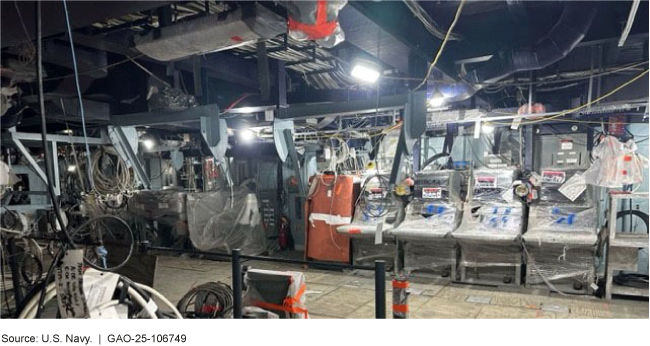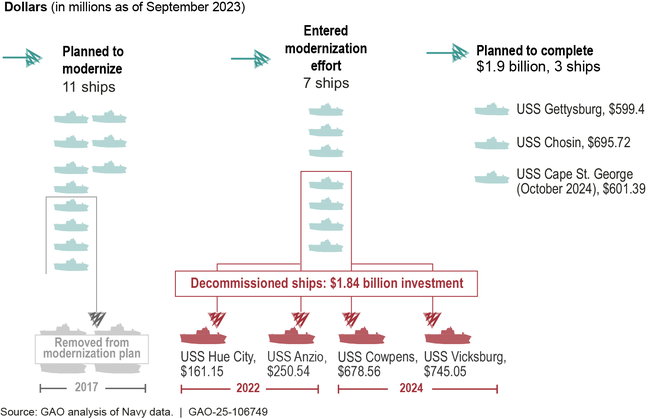Navy Ship Modernization: Poor Cruiser Outcomes Demonstrate Need for Better Planning and Quality Oversight in Future Efforts
Fast Facts
The Navy spent billions to modernize its cruisers to extend their service lives rather than retire them.
But the effort has been plagued with problems like schedule delays, wasted costs, and poor-quality work. Only 3 of 11 cruisers will complete the modernization process and won't spend as much time at sea as intended.
Weak oversight is also contributing to this issue. Navy leadership discouraged the use of key quality control tools. For example, leadership discouraged the use of monetary penalties, so contractors weren't always held accountable for their late and sometimes poor-quality work.
We recommended addressing the issues.
New Weapons Operations Computers Awaiting Installation Years After Being Delivered to the USS Vicksburg

Highlights
What GAO Found
Since 2015, the Navy has spent about $3.7 billion modernizing seven of the Ticonderoga class guided-missile cruisers—large surface combatants that provide key air defense capabilities. However, only three of the seven ships will complete modernization, and none will gain 5 years of service life, as intended. The Navy wasted $1.84 billion modernizing four cruisers that have now been divested prior to deploying. The Navy also experienced contractor performance and quality issues across the cruiser effort. For example, the contractor performed poor quality work on USS Vicksburg's sonar dome—a critical element of the Anti-Submarine Warfare mission area—resulting in additional cost and schedule delays due to necessary rework.
Status of Navy Cruiser Modernization as of August 2024

The Navy did not effectively plan the cruiser effort. This led to a high volume of unplanned work–9,000 contract changes–resulting in cost growth and schedule delays. The Navy has yet to identify the root causes of unplanned work or develop and codify root cause mitigation strategies to prevent poor planning from similarly affecting future surface ship modernization efforts.
Further, weakened quality assurance tools restricted the Navy's ability to hold contractors accountable for poor quality work. In 2018, leadership restricted maintenance officials from assessing monetary penalties to contractors without senior leadership approval. In 2020, leadership changed procedures to reduce inspections, which are a vital tool for overseeing ship repair contracts, by almost 50 percent. These actions were implemented to maintain strong working relationships with the contractors because of the Navy's dependence on them to modernize its fleet, according to Navy officials. Without reassessment, the Navy risks experiencing similar negative outcomes in future modernization efforts.
Why GAO Did This Study
In 2012 and 2013, the Navy proposed retiring several cruisers due to budget constraints. Congress rejected the Navy's proposal and provided funding to modernize these ships. In response, the Navy planned to use a phased approach to modernization that would extend 11 cruisers' service life by 5 years and upgrade the vessels' combat capability. The Navy originally planned to complete all 11 cruisers by fiscal year 2026. The Navy has other upcoming significant surface ship modernization efforts, such as for 23 destroyers. The success of these efforts is critical to the Navy having a combat-ready fleet.
A Senate report included a provision for GAO to assess the Navy's cruiser modernization. This report assesses, among other things, the extent to which (1) the Navy met its modernization objectives; (2) the Navy's planning affected outcomes; and (3) the Navy exercised effective quality control and oversight of the effort. To do this work, GAO toured five cruisers undergoing modernization, interviewed over 100 Navy officials, compared actual versus planned cost and schedule data, and reviewed Navy documentation and prior GAO reports related to Navy shipbuilding and repair.
Recommendations
GAO is making six recommendations, including that the Navy assess root causes of unplanned work, develop mitigation strategies, and codify these strategies in policy; and re-assess its overall approach to quality assurance to prevent similar issues in future surface ship modernization efforts. The Navy concurred with all six recommendations.
Recommendations for Executive Action
| Agency Affected | Recommendation | Status |
|---|---|---|
| Department of the Navy | The Secretary of the Navy should ensure that Commander, NAVSEA updates policy requiring NAVSEA 21 to consider requiring that future large-scale modernization and maintenance efforts implement planning and oversight tools used in acquisition programs. (Recommendation 1) |
When we confirm what actions the agency has taken in response to this recommendation, we will provide updated information. We will update the status of this recommendation when the Navy provides its 180-day letter (expected in summer 2025).
|
| Department of the Navy | The Secretary of the Navy should codify the cruiser modernization lesson learned that the ownership of vessels should not be transferred from the fleet to NAVSEA for major modernization efforts. (Recommendation 2) |
When we confirm what actions the agency has taken in response to this recommendation, we will provide updated information. We will update the status of this recommendation when the Navy provides its 180-day letter (expected in summer 2025).
|
| Department of the Navy | The Secretary of the Navy should direct the Chief of Naval Operations and Commander, NAVSEA to assess root causes of cruiser modernization growth work, develop root cause mitigation strategies, codify the strategies in policy, and apply them to other surface ship maintenance and modernization efforts. (Recommendation 3) |
When we confirm what actions the agency has taken in response to this recommendation, we will provide updated information. We will update the status of this recommendation when the Navy provides its 180-day letter (expected in summer 2025).
|
| Department of the Navy | The Secretary of the Navy should direct Commander, NAVSEA to re-assess its approach to overall quality assurance, including restrictions on the use of critical quality assurance tools, completion of CPARS evaluations, and the lack of an independent organization to oversee quality at RMCs, to ensure contractors are held accountable for quality. (Recommendation 4) |
When we confirm what actions the agency has taken in response to this recommendation, we will provide updated information. We will update the status of this recommendation when the Navy provides its 180-day letter (expected in summer 2025).
|
| Department of the Navy | The Secretary of the Navy should direct Commander, NAVSEA and the Chief of Naval Operations to assign specific responsibility and accountability for implementing, in a timely manner, the corrective actions identified in the 2024 NAVSEA report about modernization on surface ships. (Recommendation 5) |
When we confirm what actions the agency has taken in response to this recommendation, we will provide updated information. We will update the status of this recommendation when the Navy provides its 180-day letter (expected in summer 2025).
|
| Department of the Navy | The Secretary of the Navy should ensure that the Chief of Naval Operations documents a comprehensive assessment on operational implications of its plan to divest the three modernized cruisers in fiscal years 2026 and 2027. (Recommendation 6) |
When we confirm what actions the agency has taken in response to this recommendation, we will provide updated information. We will update the status of this recommendation when the Navy provides its 180-day letter (expected in summer 2025).
|
